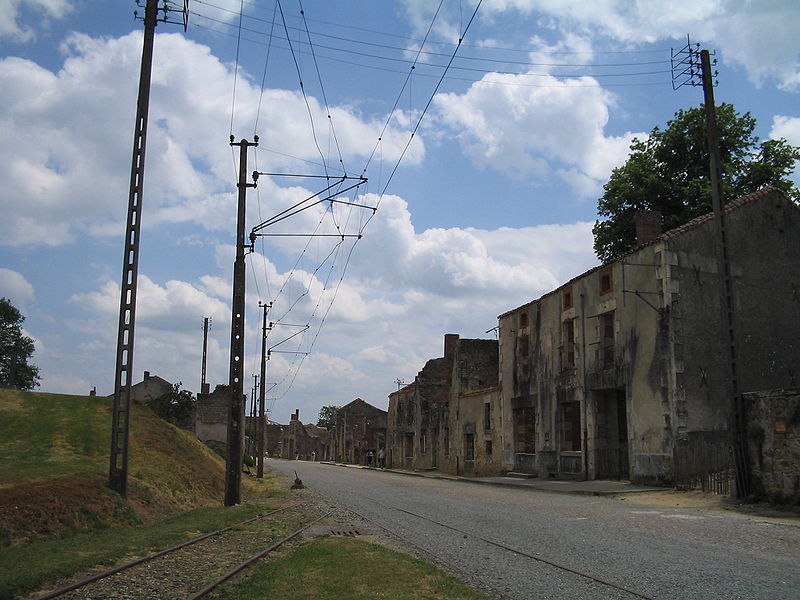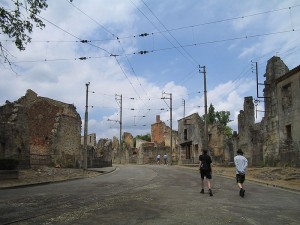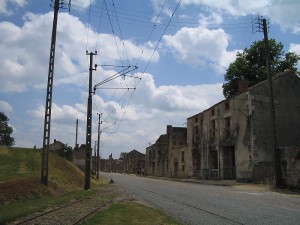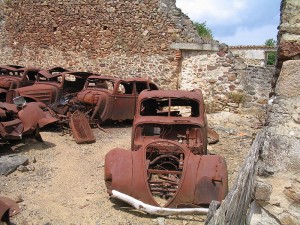
By Yusif Babanly
It’s an age-old belief that each person living on this planet has a double. There have been many notable figures in history whose lives and actions were aligned along striking similarities. But rarely do we see mind-bending parallels between two historical events and the actors involved at the same time. It is as if history reminds of its presence.
June 14, 1981 was meant to be just about any other Sunday for a 60 year-old handicapped decorator Heinz. A native of Gransee town of East German state of Brandenburg, he lived a simple life in the then socialist German Democratic Republic. Heinz reportedly ran a small grocery shop, which made Sunday a busy day to prepare for. A knock on the door announced a change of plans. At the entrance to his premises stood the law enforcement officials along with a warrant for his arrest. A shock to many, it was no surprise to the accused man. This day was expected. The dark secrets he kept in his mind for nearly four decades would come to be revealed to the public. Heinz Barth, as he came to be known at his public trial two years later, was Untersturmfürher, or the 2nd Lieutenant, of the infamous Schutz-Staffel, or as commonly known by its abbreviation, SS during World War II. That SS detachments had been considered a brutal paramilitary organization under Adolf Hitler and his crony Heinrich Himmler, and have committed numerous wrongdoings during the war is no secret. But the proportion of the arrested and convicted to the vast number of 1.25 million servicemen, who wore SS insignia but went free, is appalling. Untersturmfürher Barth was one of those who evaded justice for several decades, shanghaiing his escape via turmoil of political events in the post-war Germany and taking refuge in his native town of Gransee under a false name. Just like with many war criminals, the justice eventually snaked its way through to his doorstep on a fine Sunday morning. The crime he committed echoed out of the ashes of a calm French town of Oradour-sur-Glane in south-central France.
 In early June,1944 the 2nd SS-Panzer Division “Das Reich”, which was transferred to France from the Eastern Front, rolled its armored battalions into Limousin region. The division was moving northwest to supplement the German defense lines in Normandy, where the D-Day poured out thousands of Allied troops as part of the liberation campaign of continental Europe. The drive towards the battle for “Das Reich” would not be easy as the members of the French Resistance, also known as Maquis, showed stiff resistance, frequently attacking the German detachments along their journey. On June 9, as a detachment of “Das Reich” was resting in Rochechourart and Saint-Junien, a short drive from a small town of Oradour-sur-Glane, the commander of the 1st battalion Adolf Diekmann was notified of capture of Helmut Kämpfe, the commander of the 2nd SS Panzer Reconnaissance Battalion. Infuriated by annoying activity of French partisans, he ordered a march on an undefended town of Oradour-sur-Glane. The town had reportedly been heretofore untouched by war and thus recently became home to hundreds of refugees from Schiltigheim (part of Alsace, annexed to Germany after the fall of France in June 1940), Spaniards escaping the Spanish civil war in 1939 and lastly, Jewish victims of anti-Semitism in Nazi Germany.
In early June,1944 the 2nd SS-Panzer Division “Das Reich”, which was transferred to France from the Eastern Front, rolled its armored battalions into Limousin region. The division was moving northwest to supplement the German defense lines in Normandy, where the D-Day poured out thousands of Allied troops as part of the liberation campaign of continental Europe. The drive towards the battle for “Das Reich” would not be easy as the members of the French Resistance, also known as Maquis, showed stiff resistance, frequently attacking the German detachments along their journey. On June 9, as a detachment of “Das Reich” was resting in Rochechourart and Saint-Junien, a short drive from a small town of Oradour-sur-Glane, the commander of the 1st battalion Adolf Diekmann was notified of capture of Helmut Kämpfe, the commander of the 2nd SS Panzer Reconnaissance Battalion. Infuriated by annoying activity of French partisans, he ordered a march on an undefended town of Oradour-sur-Glane. The town had reportedly been heretofore untouched by war and thus recently became home to hundreds of refugees from Schiltigheim (part of Alsace, annexed to Germany after the fall of France in June 1940), Spaniards escaping the Spanish civil war in 1939 and lastly, Jewish victims of anti-Semitism in Nazi Germany.
Upon entering the town and surrounding helmets on the morning of June 10, the Nazis forced out all residents from their houses and rounded them up at the central market square. At the peak of afternoon hours, the SS detachment separated men and women and children in groups, sending the former to the six selected barns and the latter to the town’s church. Then started the bloodbath. The male residents were shot in their legs at the barns so as not to escape and were then set ablaze. The screams of women and children locked up in an old church were met with hand grenades and machine gun fire. The entire village would soon be engulfed in flames and the only six survivors appreciated divine intervention as they miraculously crawled their way out of the hell on earth. Those wounded, spotted in crawling motion were finished off by shots at close range.
 In a matter of a few hours, a total of 642 French residents of the town were brutally killed, of them 247 women and 205 children. The Oradour-sur-Glane Massacre came to be known as one of the most heinous war crimes in the days of World War II. Yet, as the war of liberation of France was won by the Allied forces and the Third Reich defeated, the perpetrators of this horrific crime went unpunished for years. Thirty former SS officers out of nearly 200 perpetrators were reportedly tried in three subsequent trials since 1953, twenty one of whom were sentenced to death but not executed for the sake of “national reconciliation” between France and Germany. The trial of Heinz Barth was the first case of resolute punishment for the atrocities committed at Oradour-sur-Glane. Overshadowed by his irrevocable misdeeds in Oradour where he personally gave orders to a group of machine-gunners to execute the villagers at point-blank range and fired 15-20 shots himself, Barth broke down and confessed during the proceedings. In the presence of surviving victims of the massacre, on June 7, 1983, the East German Judge Heinz Hugot sentenced the former SS officer to life in prison and ordered stripping him of his East German citizenship. As a handicapped veteran, who lost one of his legs during the war, the Untersturmfürher limped his way to the prison. Serving just 14 years of his sentence, he was released in 1997 due to his ailing health. Since the release, in what is now the unified Germany, he had lived a quiet life in his hometown, where he would find cancer and die in August of 2007, at the age of 86.
In a matter of a few hours, a total of 642 French residents of the town were brutally killed, of them 247 women and 205 children. The Oradour-sur-Glane Massacre came to be known as one of the most heinous war crimes in the days of World War II. Yet, as the war of liberation of France was won by the Allied forces and the Third Reich defeated, the perpetrators of this horrific crime went unpunished for years. Thirty former SS officers out of nearly 200 perpetrators were reportedly tried in three subsequent trials since 1953, twenty one of whom were sentenced to death but not executed for the sake of “national reconciliation” between France and Germany. The trial of Heinz Barth was the first case of resolute punishment for the atrocities committed at Oradour-sur-Glane. Overshadowed by his irrevocable misdeeds in Oradour where he personally gave orders to a group of machine-gunners to execute the villagers at point-blank range and fired 15-20 shots himself, Barth broke down and confessed during the proceedings. In the presence of surviving victims of the massacre, on June 7, 1983, the East German Judge Heinz Hugot sentenced the former SS officer to life in prison and ordered stripping him of his East German citizenship. As a handicapped veteran, who lost one of his legs during the war, the Untersturmfürher limped his way to the prison. Serving just 14 years of his sentence, he was released in 1997 due to his ailing health. Since the release, in what is now the unified Germany, he had lived a quiet life in his hometown, where he would find cancer and die in August of 2007, at the age of 86.
France paid a high price during its war for liberation from Nazi occupation. Aside from losing all of its residents – save six survivors – to the massacre, 328 historical buildings in the town of Oradour-sur-Glane were reduced to rubble. Slow investigations into the war crimes notwithstanding, civilized world after the defeat of evil ensured that perpetrators of war crimes had to be looked for and eventually found.
 In another country, at another time, one man still gets up in the morning, free from worries of being detained and ironically under the securities of international-law-imposed immunity. Since April 14, 2008 he’s been serving as the Minister of Defense of the Republic of Armenia. In Armenia, he is a glorified hero for having taken an active part in the war against Azerbaijan. Native of the town of Shusha, formerly populated by Azerbaijanis before its occupation on May 8, 1992, Seyran Ohanian served in the Soviet Armed Forces as an officer in the 366th Motor Rifle Regiment stationed in Khankandi (Stepanakert). Embraced by the ideology of Armenian nationalism, Ohanian led Armenian troops against many Azerbaijani towns and villages; however his name became more discernable after the tragedy in Khojaly.
In another country, at another time, one man still gets up in the morning, free from worries of being detained and ironically under the securities of international-law-imposed immunity. Since April 14, 2008 he’s been serving as the Minister of Defense of the Republic of Armenia. In Armenia, he is a glorified hero for having taken an active part in the war against Azerbaijan. Native of the town of Shusha, formerly populated by Azerbaijanis before its occupation on May 8, 1992, Seyran Ohanian served in the Soviet Armed Forces as an officer in the 366th Motor Rifle Regiment stationed in Khankandi (Stepanakert). Embraced by the ideology of Armenian nationalism, Ohanian led Armenian troops against many Azerbaijani towns and villages; however his name became more discernable after the tragedy in Khojaly.
On February 25-26, 1992, a town of Khojaly in Nagorno-Karabakh region of Azerbaijan experienced the fate similar to one of Oradour-sur-Glane. Khojaly was one of the two remaining Azerbaijani-populated towns in Nagorno-Karabakh, still defending against the incessant attacks of Armenian armed forces. Much like Oradour-sur-Glane, it became home to many Azerbaijani refugees from Armenia and Ahiska Turks from Fergana valley of Uzbekistan. The Armenian-Azerbaijani conflict had started in 1988, when Armenia laid territorial claims on Azerbaijan, escalating into a full-fledged war by early 1992. By the end of February, Khojaly was living under siege for several months. On the night of February 25, after an hour-long shelling of the town, columns of armored vehicles moved into Khojaly from three sides. Defended by a small group of lightly armed militia, the town was quickly overrun by the Armenian detachments and the tanks of the 366th regiment of CIS forces – the officer personnel of which was overwhelmingly Armenian – stationed in an already occupied Khankendi (Stepanakert). Frostbitten by the mountainous climate, a few hundred civilians rushed through the woods and narrow passages out of the encirclement towards the safety of Azerbaijani town of Agdam. Not all of them would reach the intended refuge. By the village of Nakhchivanli (formerly Nakhchivanik), a hail of Armenian bullets would befall them as they scattered over the naked hills of Karabakh. By the dawn, 613 innocent residents of Khojaly, of them 106 and 83 children lay dead in Khojaly and near Nakhchivanli. Those who did reach safety with frostbitten feet spoke of the horror. In the immediate aftermath, Azerbaijani and foreign journalists flew in and documented the site of the killing by Nakhchivanli and in Khojaly (photographs taken by Russian journalist Victoria Ivleva attest to indiscriminate killing of women and children in the town of Khojaly itself, as well). Despite the enormous outcry, no justice had so far been served to the victims of this horrendous war crime. Among the accused for taking part in the massacre and directing the ethnic cleansing operation in Khojaly are the incumbent President of Armenia Serzh Sargsyan, his predecessor in that office, Robert Kocharyan, Defense Minister Seyran Ohanian – all natives of Karabakh region. In 2010, based on criminal investigation, Prosecutor’s Office of the Republic of Azerbaijan published names of 38 identified perpetrators of Khojaly Massacre, among them 12 local administration officials of then already abolished NKAO (the status of Nagorno-Karabakh Autonomous Oblast was abolished on November 26, 1991 by the Parliament of Azerbaijan), 14 officers of 366th Motor Rifle Regiment of the 23rd Motor Rifle Division of former Soviet Ground Forces, including the regiment commander Yuriy Zarvigorov, head of the reconnaissance of the first battalion of the 366th regiment Valeriy Chirchian and others. In addition to the army-trained Armenian servicemen, there were also paramilitary detachments such as “Arabo” and “Aramo” composed of ethnic Armenians from Armenian communities abroad, some of whom have taken part in terrorist activities beyond Azerbaijan’s borders at one time or another, probably the most infamous one being Monte Melkonian, convicted for his role in Orly Airport attacks in July of 1983.
As one of the architects of the Khojaly tragedy and ethnic cleansing of its entire population, the information on the accused Seyran Ohanian, along with many other perpetrators had been passed to Interpol. However, due to immunity for holding a public post in the Republic of Armenia, Ohanian enjoys the freedom from justice.
The similarities between the massacres of Oradour-sur-Glane and Khojaly are mind-boggling, to say the least. Composition of residents in both Oradour-sur-Glane and Khojaly is remarkably near-identical. Both towns had a significant number of displaced persons from various areas of conflict who found refuge there years before the destruction of the town took place.
The nature and intent of both massacres speaks of another similarity. As in the case of Oradur-sur-Glane, the perpetrators of the massacre in Khojaly sought maximum destruction, extermination of the residents of the town, and caused emotional terror behind enemy lines. Both SS troops and Armenian detachments inflicted significant physical damage, the former by burning down Oradour-sur-Glane, the latter by indiscriminate shelling and burning parts of the occupied Khojaly. A noteworthy similarity is the near-exact statistics on the victims of the massacres. By an official count, the total of the massacred in the French town of Oradour-sur-Glane was 642, whilst the number of the massacred in Azerbaijani town of Khojaly stands at 613.
Another notable resemblance of these two war crimes is the audacious denials of the parties involved. In an utterly disgusting form of justification, the Nazi version of Oradour-sur-Glane Massacre maintains that the wiping out of an entire population of the town can be justified on the ground of “discovery of weapons in houses and barns”, allegedly stored by French partisans, although there is no credible evidence supporting the claim. To that end, the SS version at the Nuremberg trials in November 1945, where high ranking Nazi military commanders Alfred Jodl and Wilhelm Keitel were among the defendants, the defense contended that since the SS detachment found weapons in houses and barns in Oradour-sur-Glane and because Helmut Kämpfe was killed by the French partisans, allegedly hiding in the village, the soldiers under Nazi command had a legal right to kill innocent civilians under the 1929 Geneva Convention, which presumably provided room for reprisals under international law at the time, although at the same time it was definitely a war crime since it violated the laws and usages of war under the 1907 Hague Convention, specifically Articles 46 and 50. These arguments are reiterated by the former SS soldier and author of ‘SS Panzergrenadier’, Hans Schmidt who justified the attack on the town’s civilians reasoning that the area in question has been a “hotbed of resistance” against the German occupiers.
The perpetrators of Khojaly Massacre have, in turn, exercised a starkly shallower form of denial by indomitably claiming that the Armenian forces did not take part in any killings of Azerbaijani civilians in Khojaly and its surroundings, and that the Azerbaijani servicemen themselves massacred their own civilians at the footsteps of Agdam or prevented the civilians from fleeing the Armenian attack. There has been no evidence to corroborate these claims, as the outcome of the massacre has been well documented by international media and human rights organizations. To that end, Holly Cartner, the Executive Director of Human Rights Watch officially responded to the Foreign Affairs Ministry of Armenia in 1997, stating that the HRW “places direct responsibility for the civilian deaths with Karabakh Armenian forces. Indeed, neither our report nor that of Memorial includes any evidence to support the argument that Azerbaijani forces obstructed the flight of, or fired on Azeri civilians” and that “The circumstances surrounding the attack . . .on those fleeing Khojaly indicate that [Karabakh] Armenian forces and the troops of the 366th CIS regiment . . .deliberately disregarded this customary law restraint on attacks” (Response to Armenian Government Letter on the town of Khojaly, Nagorno-Karabakh, Human Rights Watch, March 24, 1997). At another oft-repeated extreme, Armenian military leaders claimed that the massacre of Azerbaijani civilians at Khojaly was a reprisal for the killings of 26 Armenians, who died during Sumgayit events in February 1988, which also took 6 Azerbaijani lives and was completely communal in nature, whereas the Khojaly Massacre was extermination of one unarmed ethnic group by another armed one.
And last but not least, is the similarity of two perpetrators Barth and Ohanian, both commanders of their respective death squads at the time of the massacres. “Butcher of Oradour”, as Barth would come to be labeled after his notorious trial for his role in the war crimes, started his ill-fated career with enlisting in “Hitler’s Youth” in 1932. Shortly thereafter, he found himself in the military police before joining SS in 1943. After participating in the Oradour-sur-Glane Massacre, he moved on to Normandy, where in August of the same year he was seriously wounded and had his left leg amputated. For services rendered to the Third Reich, Barth was promoted to Obersturmfürher, or First Lieutenant, before the Nazi Germany was defeated. This is when the SS officer disappeared into thin air until resurfacing in 1981. In 1983, as the “Butcher of Oradour” was publicly tried and sent to the East German prison, by a twist of fate and as if to personally receive the inglorious baton from the departing criminal, Seyran Ohanian arrived in East Germany to serve in the Soviet Occupation Forces. In 1988, Ohanian was transferred to the Transcaucasian Military District’s 366th regiment, deployed in Khankendi (Stepanakert). After his participation in the massacre in Khojaly, he was severely wounded the same year in Childiran village and like Heinz Barth, had his left leg amputated. For his role in the war against Azerbaijan, he was sonorously promoted over and over until he attained the post of the Foreign Minister of Armenia. His wrongdoings were discreetly suppressed and swept under the rug.
In some respects, Barth and Ohanian are culpable doppelgangers. Although they never knew each other, both officers, aggrandized in their countries, share similar life journey.
No matter how many years pass, how much pain the victims endure, the justice will eventually prevail. The conviction of one the perpetrators, Heinz Barth and a new re-opened investigation into the massacre in Oradour-sur-Glane in January 2013, searching for six more perpetrators who may still be alive, fortifies a sanguine faith that one day those who are guilty of misdeeds in Khojaly will hear the pummeling knock on the door that will change their lives forever.
Yusif Babanly is co-founder and board member of the US Azeris Network (USAN)
Photos: Courtesy of Wikimedia




